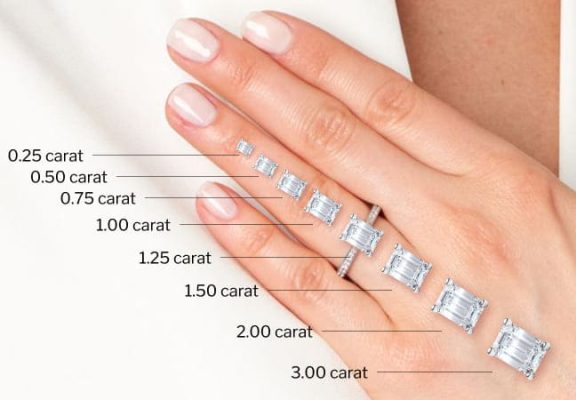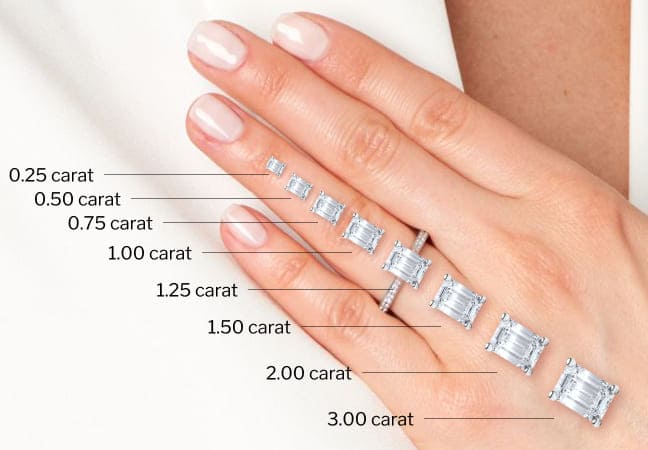I’m Certified Gem Knowledge, and I’ll guide you through understanding diamond carat weight – what it really measures, how it impacts price, and how it compares to visual size. Let’s weigh the options!
What is Diamond Carat Weight? Defining Weight vs. Size
Let’s clear up a common confusion right away: carat weight is not diamond size. While they are related, they aren’t the same thing. So, what is the carat unit definition? Carat is the standard unit of weight used specifically for diamonds and other gemstones. It’s a precise diamond mass measurement.
Carat: A Standard Unit of Weight
The definition is simple: one carat equals 200 milligrams (1 Carat = 200 Milligrams – ~0.007 ounces). Or, put another way, that’s 0.2 grams. The milligram is the base unit for the carat definition. Why this specific unit? The history is interesting! Carat originated from carob seeds. Early gem traders historically used carob seeds as consistent counterweights on their scales. Eventually, the carat became the internationally recognized gemstone weight standard.
Why Carat Weight Isn’t the Same as Diamond Size
While a heavier diamond is generally bigger, carat weight differs from diamond size. Diamond size refers to the physical dimensions you see – usually the width and length measured in millimeters.
Two diamonds can have the exact same carat weight but look different in size! How?
- Diamond Cut: The quality of the cut significantly influences perceived size. A shallow cut diamond might have a larger apparent size for its weight, spreading the weight outwards. Conversely, a deep cut diamond might hide weight in its depth, making its apparent size for weight smaller. Cut quality affects visual size for a given weight.
- Diamond Shape: The shape influences how large a carat looks. Elongated shapes like Oval, Marquise, or Pear often appear larger face-up than a Round diamond of the same carat weight because the weight is distributed differently. The diamond shape influences perceived size, too.
So, remember: carat measures diamond weight, not necessarily how big it looks face-up.
How Carat Weight Influences Diamond Price and Rarity
Carat weight affects diamond price – often dramatically. This weight value relationship is tied directly to diamond rarity. Simply put, larger diamonds are rarer than smaller diamonds. Finding large, gem-quality rough crystals is much harder than finding smaller ones. Larger rough crystals are rarer than smaller rough crystals, and this scarcity means larger diamonds have higher rarity. Because rarity drives diamond price, the cost increases significantly as carat weight goes up. Rarity is a major factor in diamond pricing.
But the price doesn’t just increase steadily; it increases exponentially. Price per carat increases exponentially with weight. This means the diamond price increase nature is exponential. A 2-carat diamond doesn’t just cost twice as much as a 1-carat diamond of the same quality – it costs more than twice as much, because the price per carat increases with weight. Higher carat weight generally means higher price.
Of course, carat weight is one of the 4 Cs, but it’s not the only factor. The final diamond price reflects a combination of carat weight, cut, color, and clarity. The overall diamond value depends on all 4 Cs.
“Magic Sizes”: Understanding Key Weight Thresholds
Have you noticed how diamond prices seem to jump at certain weights? That’s because of magic sizes. These magic sizes are key weight thresholds causing price jumps. Common magic sizes (pricing thresholds) include the 0.5 carat diamond (half-carat), 0.75 carat (three-quarter carat), the popular 1 carat diamond, 1.50 carat, 2.00 carat, and so on.
Why do magic sizes cause significant price jumps? Two main reasons:
- Demand: Consumers often desire magic sizes. Being able to say “it’s a one-carat diamond” holds a certain appeal.
- Cutting Strategy: Diamond cutters often aim to reach these thresholds to maximize value, making stones right at or above these weights highly sought after.
This phenomenon means magic sizes impact pricing strategy. But it also creates a smart shopping opportunity! The strategy of “buying shy” means choosing a weight just below a magic size (like 0.96 ct instead of 1.00 ct). The visual difference is usually impossible to see, but the price difference can be substantial. “Buying shy” is a strategy to avoid magic size premiums. This weight rarity correlation at specific points drives the market.
Measuring Carats
How do gemologists talk about diamonds weighing less than one carat? They use the points system unit. This diamond scale unit makes discussing precise weights easier.
The system is straightforward: one carat equals 100 points (1 Carat = 100 Points). The points system subdivides the carat. So:
- A 0.50 carat diamond is called a “50-pointer”. A 0.5 carat diamond has a common term: half carat.
- A 0.25 carat diamond is a “25-pointer”. A 0.25 carat diamond has a point value of 25 points.
- A 0.95 carat diamond is a “95-pointer”.

Points allow precise measurement below one carat. Diamond weight is measured precisely, often to the hundredth decimal place (carat measurement precision is to the hundredth decimal place). This high accuracy is achieved using a specially calibrated diamond scale (tool). The diamond scale measures carat weight. GIA grades carat weight precisely, listing it on the report. Among the 4Cs, carat weight has high objectivity.
Choosing Your Diamond Carat Weight: Practical Considerations
While carat weight is important, choosing carat involves balancing priorities. Don’t focus solely on weight; consider the whole picture.
Balancing Carat with Your Budget and the Other Cs
Your budget often dictates the attainable carat weight, as budget influences carat choice. Decide what’s most important to you. Would you prefer a larger carat weight with slightly lower color or clarity, or prioritize cut quality in a slightly smaller stone? Remember, value depends on carat weight and other Cs.
Considering Visual Size: Shape and Setting Matter
As we discussed, shape affects how big a diamond looks. Elongated shapes often provide more visual size for the same weight. Also, the jewelry setting can make a difference. A halo setting, for instance, adds sparkle and makes the center stone appear larger. Even gemstone density affects the size-to-weight ratio, though this is more relevant when comparing different types of gems.
Understanding Total Carat Weight (TCW)
Sometimes you’ll see “TCW” or “CTTW” listed. This stands for Total Carat Weight. TCW represents the combined weight of multiple stones in a single piece of jewelry. Total carat weight sums the weight of multiple diamonds. For example, the TCW for diamond stud earrings is the weight of both diamonds added together. Similarly, for a halo ring or a ring with side stones, total carat weight is calculated for multi-stone jewelry. Knowing TCW is important for earrings and halo rings to understand the weight distribution.
Carat weight is a fundamental ‘C’, but it’s more than just a number. It’s about weight, rarity, price, and how it interacts with cut, shape, and setting. Hopefully, this guide from Certified Gem Knowledge helps you navigate your choices!


